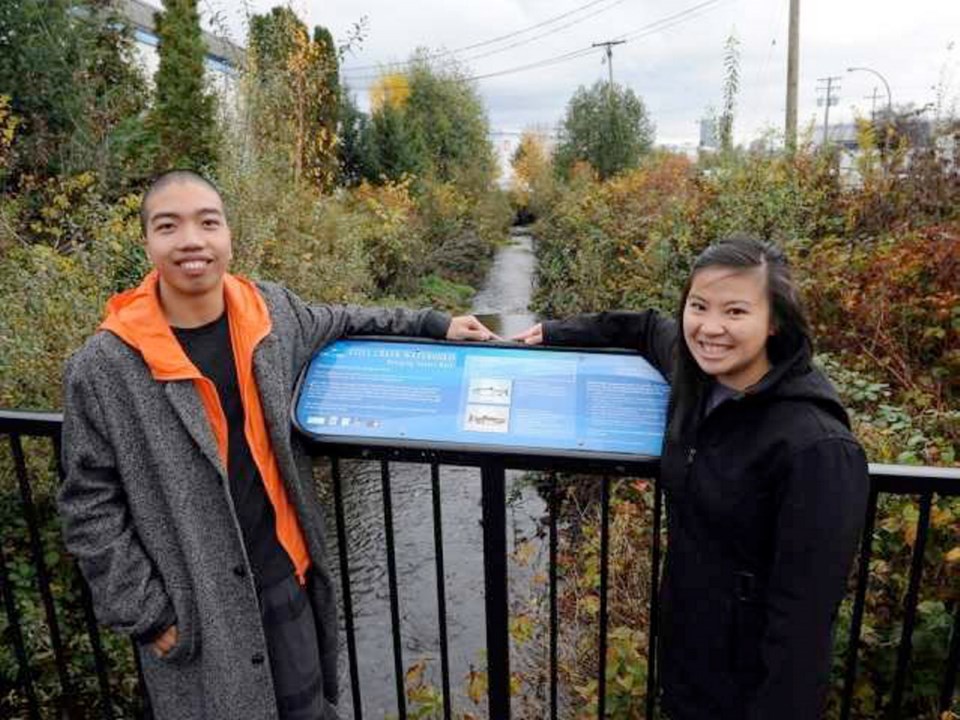A bumper return of chum salmon to B.C.’s south coast is flooding urban streams in Metro Vancouver, inspiring dedicated streamkeepers, providing easy viewing opportunities for the public and offering hope for the coexistence of nature in a modern metropolis.
“These ones have passed the natural-selection process,” said Crecien Bencio, peering down from a foot bridge into Still Creek in industrial east Vancouver. “They’ve avoided the bears and the eagles. They’ve beaten the odds.”
They’ve avoided the people, too. Commercial fishermen have taken an estimated 173,000 chum out of a predicted return of two million to the Fraser River, helping to offset dismal sockeye runs last summer that kept fishing boats at dock. Aboriginal fishing continues for chum.
“We’ve had significant abundances, the biggest return in about 10 years,” Jennifer Nener, Fisheries and Oceans Canada’s regional salmon director, said in an interview Tuesday. “It’s all good news, very positive. Not a record, but giving people opportunities.”
Chum returned to Still Creek five years ago for the first time in about eight decades. Spawning activity can be viewed at the corner of Natal Street and Cornett Road, just upstream from Vancouver Film Studios and downstream from Canadian Tire.
These fish swam up the Fraser River, then diverted up the Brunette River to Burnaby Lake and on to Still Creek. Among the other streams experiencing returns are Stoney Creek, Guichon Creek, Eagle Creek, Deer Lake Brook and Buckingham Creek.
“This is literally a salmon miracle in the city,” said Mark Angelo, rivers chair of the Outdoor Recreation Council of B.C. “It’s particularly exciting that young people can witness salmon spawning in these numbers in that it reconnects them with one of nature’s most amazing spectacles.”
Coho are also spawning in some creeks.
Bencio is president of Still Moon Arts Society, one of scores of community groups in the region that have worked for years on habitat improvement of local streams and on public education. “It’s quite magical that salmon can return to spawn in Vancouver,” he said.
Kaitlyn Fung, an editorial assistant with the society, added: “We use art to get people to consider the nature around them. Most people don’t even know. I’ll be standing here 20 minutes and they still don’t really get what’s going on. That says something about the work that needs to be done to raise awareness.” A book, Still Creek Stories, is in the works.
Santino Scardillo, a City of Vancouver worker, wandered over to look for himself. “It’s nice to see life come back,” he said. “I remember in the day, it was a disaster, shopping carts. The people who volunteered have done a great job. To see this on the East Side, who would have known.”
He lives in Port Coquitlam and has witnessed an impressive return of salmon in that area, too, this fall, to the benefit of people and nature.
Nener noted that chum and sockeye have different life cycles, but said she cannot pinpoint why one species did better than the other this year.
“It’s hard to say what came into play. It’s interesting, the variable returns we’ve seen across the coast and across the species.”
In short coastal streams, chum emerge from gravel spawning beds in the spring as fry and — unlike sockeye — move directly to the sea. Most chum spend two or three summers at sea before returning to their home streams to spawn, according to federal fisheries.
Chum are the poorest jumpers of the Pacific salmon world and waterfalls that do not impede any of the other species can often stop their upstream migration. It is a preferred fish for cold-smoking, due to the low oil content of the flesh.
Commonly referred to as dog salmon because of the males’ sharp teeth during spawning, chum is the least sought after of the Pacific salmon species, though it has long provided a food staple for coastal peoples due to its abundance in the region. The roe is harvested and the flesh used for speciality products such as Indian candy.



